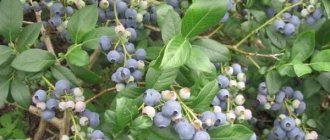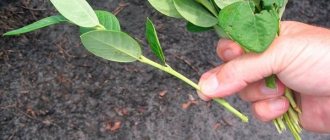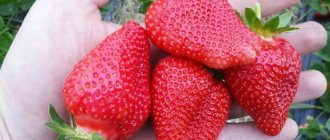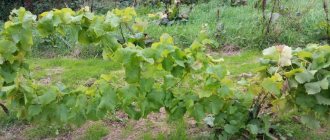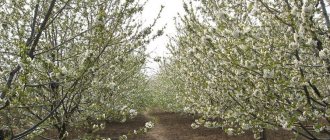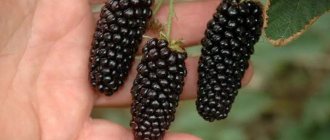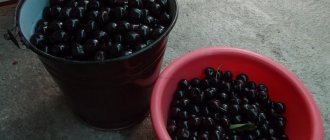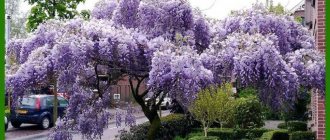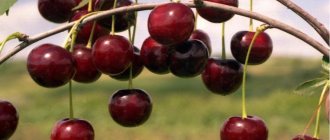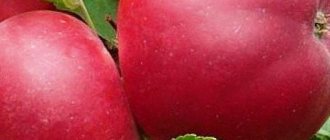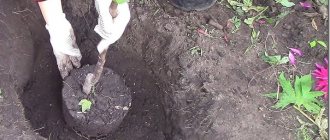Description of the berry crop
Shrubs of mid-early ripening are characterized by stable high yields. The first berries are tasted in the second year after planting.
Important! The shrub develops well and bears fruit, provided that care requirements are met, especially regarding the composition of the soil.
General idea of the variety
A bush variety with a fibrous root system that goes deep by 15-20 cm, grows quickly, creates a lot of shoots, up to 5 shoots per season. The height of the Duke blueberry is 1.5-2 m. The circumference is the same. Erect skeletal shoots are green, brown in the sun. They branch weakly, which gives an additional advantage in the northern regions: the plant and the set fruits are well warmed by the sun. Fruitful branches are thin, with a bend. Only with age does the bush thicken.
Oval leaves up to 6-8 cm long, 3-4 cm wide, with short petioles. They turn red in autumn. The edges of the leaf blade are entire, the surface is smooth. Duke blueberry flowers are soft white with a slight pink tint, collected in clusters of up to 10 pieces. They have the shape of an elegant bell, 1 cm wide.
Berries
The fruits of the highbush blueberry variety Duke are large, round, slightly flattened, measuring 17-20 x 12 mm, and not uniform. Weight 1.8-1.9 g, up to 2.5 g. The skin of the berries is blue, with a bluish coating, smooth texture, strong, elastic, pleasantly crunchy. The juicy greenish pulp is dense and contains many seeds. The pleasant sweet and sour taste of the Duke blueberry variety is distinguished by its piquant tartness and aromatic aftertaste, which becomes more pronounced during storage. The tasters' rating was high - 4.8 points.
Reviews
Alexander, Volgograd
— Duke and several other varieties of blueberries have been growing for me for 10 years. In comparison, I can say that an adult plant bears fruit better. The bush has grown very much and is covered with berries. The taste is excellent - we enjoy eating fresh, juicy, tasty berries. They keep well in the refrigerator for two weeks. I don’t use any special agricultural techniques, except that I use fertilizers for rhododendron and azaleas. I noticed that the harvest has become larger. My advice when buying a seedling: make sure that the roots do not intertwine into a lump. Such a root system does not take root well, since the seedling was overexposed and fed with long-term fertilizers.
Marina Sergeevna, Pskov
— Duke, 2 bushes, grown with cuttings from neighbors. I grew seedlings at home because the dacha is far away and difficult to travel to. I sprouted it under a bag near the balcony door in a bucket. By spring the bushes had grown stronger, and I planted them in mid-April, as soon as I arrived at the dacha. The strengthening went without any problems, and the plants went into winter strong. I covered it for the winter, since I’m not nearby - in November I compactly tied the branches and wrapped the bushes in old bags, and raked the earth to the trunk. When it grows up, I probably won’t cover it, because the neighbors don’t cover their 6-year-old blueberry bushes, and they winter well.
Characteristic
According to reviews of the Duke blueberry variety, the plant is economically profitable.
Main advantages
The shrub will become an abundant source of vitamin products in the northern regions, because it can withstand frosts of up to 34 degrees. Plantings of the Duke blueberry variety in the middle climate zone emerged without losses after a harsh winter with a 40-degree cold. The plant is moisture-loving; it requires a lot of water to wet the entire root ball.
Planting and caring for Duke blueberries is not difficult. The composition and structure of the soil is important for the plant:
- acidity within 4.3-4.8 pH;
- loose, light mechanical composition of the soil;
- the presence of 40-50 g of sulfur per square meter of area.
The variety is readily planted due to its excellent transportability and extended shelf life - up to two weeks in a cool place.
Flowering period and ripening time
The Duke variety blooms in the last ten days of May. But even with a sudden drop in temperature, the flowers remain. Another significant advantage of the bushes is self-fertility. Although in reviews of Duke blueberries there is advice to plant several plants nearby for better pollination. The period from flowering to the start of fruit harvesting is 42-56 days. The berries are harvested in two or three approaches, starting from the twentieth of July until mid-August.
Yield indicators, fruiting dates
As the bush ages, the berries do not become smaller. The Duke variety is reliable, productive, and high-yielding. The berries are separated with a dry separation; mechanized harvesting is also possible. Plants with comprehensive care yield up to 6-8 kg. The tall blueberry bush Duke is early-bearing: the berries are set in the second year after planting. The plant produces a solid harvest for 20 years.
Area of application of berries
The Duke variety is universal, suitable for freezing and cooking. Considering the shelf life of the fruit in the refrigerator, you can treat yourself to this healing delicacy for a month and a half.
Attention! Berries will bring the greatest benefit if consumed fresh.
Resistance to diseases and pests
With proper planting and care of tall blueberries, the plant is little affected by pests. For fungal diseases, traditional early spring treatment with fungicides is used.
Advantages and disadvantages of the variety
Distinctive properties brought the Duke variety into the list of plants of industrial importance:
- early ripening;
- large-fruited;
- with a pleasant taste and aroma;
- productive;
- friendly ripening of berries;
- transportable;
- frost-resistant;
- resistant to pests.
The only imperfections of the variety include the specific requirements of the bushes for the special composition and moisture of the soil.
Strengths of the variety
- Large berries and good stable yield, a large percentage of one-dimensional fruits.
- Late flowering period, protecting flowers from spring frosts.
- Friendly and very early ripening of fruits, the ability to carry out mass sampling. Thanks to this, Duke is of particular interest to the fresh berry market, allowing it to sell a larger quantity of the crop at a high price.
- Strong growth energy, moderate branching of lateral shoots.
- Good transportability and keeping quality of berries.
- The versatility of fruit use.
- Sweet, juicy berries with aromatic pulp and a rich aftertaste.
- The hardiness of the variety and adaptation to various growing conditions both in the north and in the south.
- Resistance to major blueberry diseases.
- Possibility of using the plant for decorative purposes.
How does Duke blueberry reproduce?
The shrub is propagated in nurseries by seeds, but such seedlings will yield a harvest only after 8 years. The most convenient propagation of Duke blueberries is by layering and cuttings:
- A shoot is placed in a groove near the bush with peat and sawdust, secured and covered with film. The sprouts are dug up after 1-2 years.
- Cuttings cut in the fall are rooted in the substrate in the spring. From the greenhouse, the sprouts are moved into the ground in the fall, protected from frost.
Advice! It is necessary to plant Duke blueberries on the site after rooting after 2-3 years.
Landing rules
For a good harvest, it is important to plant the bushes correctly.
Recommended timing
In the middle zone, Duke blueberries are planted in the spring. By autumn the bushes take root. In the south they are also moved in early autumn.
Choosing a suitable location
Garden varieties are placed in well-lit, drained areas. In the northern regions, places protected from cold winds are chosen. Groundwater should lie no higher than 0.6 m.
Soil preparation
To plant Duke blueberries, a sand-peat substrate is prepared. The soil is acidified:
- peat;
- citric acid;
- table vinegar.
On alkaline soils, be sure to check the acidity with instruments. A year before planting, sulfur is added to the site.
On alkaline soils, spacious pits are prepared for the substrate: 0.8 x 0.8 m, 60 cm deep. Agrotextiles are placed at the bottom, which will help maintain the created acidity. A layer of gravel and sand for drainage, then the required soil:
- 60% acid peat;
- 20% old pine needles;
- 10% each of crushed pine bark and fine sawdust.
Comment! The best site for blueberries is one where herbs were grown and no organic matter was used.
Selection and preparation of seedlings
For moving, choose 2-3-year-old bushes with elastic branches, without damage to the bark, and with a closed root system.
Algorithm and landing scheme
The distance between bushes of the Duke variety is at least 1.2-1.5 m. The planting procedure is usual:
- The seedling is placed 4 cm lower than it grew in the container.
- The root collar deepens.
- The bush is pruned.
- The hole is watered and mulched.
Cultivation history
At the dawn of the 20th century, American breeders began cultivating blueberries and southern blueberries. At the same time, the first industrial varieties were obtained. By the beginning of the 80s, 45 types of highbush blueberries, 11 varieties of the “rabbit eye” type and 3 lowbush varieties had already been included in the register (now there are more than 130 of them).
In nature, wild blueberries begin to bear fruit quite late - it takes at least 15 years for the first berries to appear. Garden species produce a harvest already in the second year of planting.
Blueberry Duke is a tall form. Brought out in the USA in 1972 as a result of crossing the Ivanhoe and Early Blue varieties, it was approved for industrial breeding in 1987.
Blueberries of the Duke variety are distinguished by early ripeness and smooth ripening of fruits
Blueberries have many popular names: tit, blueberry, gonobobel, drunkard. The berry is very healthy and does not cause allergic reactions, so it is recommended to include it in children's menus.
Subsequent care of the crop
According to descriptions of the Duke garden blueberry, this is an unpretentious variety.
Necessary activities
The soil is loosened and mulched after watering. Water twice a week, 10 liters per bush, do not allow water to stagnate. Fresh manure cannot be fertilized. Take mineral preparations:
- nitrogen in the form of ammonium;
- potassium sulfate.
- superphosphate.
Shrub pruning
Duke blueberry care includes pruning in the 4th year. In early spring, lower drooping shoots are removed, and damaged branches are cut off on straight ones. The procedure is carried out taking into account that the fruits are set on 2-year-old growths. In the 9th year, 20% of the old branches are cut off.
Preparing for winter
Despite the frost resistance of Duke blueberries, in regions with harsh and snowless winters, the bushes are mulched and covered with agrofibre. If snow falls, it is applied to the plants.
Diseases and pests, methods of control and prevention
When bushes thicken, outbreaks of fungal diseases are possible.
| Diseases | Signs | Treatment | Prevention |
| Anthracnose | Dark spots on shoots and leaves, fruits | "Fitosporin-M" or fungicides | Removing fallen leaves |
| Gray rot | Gray spots of mycelium, rotting | Give nitrogen preparations strictly according to the norm, thin out the bush | Treatment in early spring with iron sulfate, at the end of May with Bordeaux mixture |
| Cancer | Cracks and red sores on the bark | Thinning pruning | Apply "Azofos", "Skor" |
Pests rarely attack the plant.
| Pests | Signs | Treatment | Prevention |
| leaf roller | Leaves are curled, buds and flowers are damaged | Insecticides | Removing fallen leaves and carrion |
| Chafer | The leaves turn yellow - the larvae gnaw the roots | "Antikhrushch" | Shaking off, light traps |
| Aphid | Damaged leaves | Soap or soda solution | Fighting ants |
